Blog 03/19/2021 - History of the Iron Cross
The History of the Iron Cross by Rich Yoder, MHT Historian.
Few military decorations have such a long history as the Iron Cross. Created by King Friedrich Wilhelm III of Prussia, during the Napoleonic Wars, the date of issue was backdated to 10 March 1813, the birthday of the late Queen Louise. The first Iron Cross was awarded posthumously to the Queen. Although called the Iron Cross, the first iteration of the award was made of cloth and sewn on the left breast pocket of the uniform.
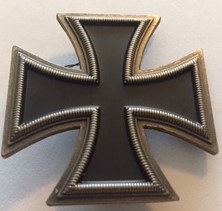
Later iterations were made of iron. The original Iron Cross was blank. It was just a simple cross of iron. The First Class version had no ribbon and was attached to the uniform by a pin or screw. Hence they are known as screw-back or pin-back medals. The Second Class version was suspended from a black ribbon with two white stripes. These were the colors of the Hohenzollerns, the ruling family of Prussia. The Iron Cross Second Class had to be earned before the First Class version could be awarded. However, both versions could be earned in the same combat engagement.
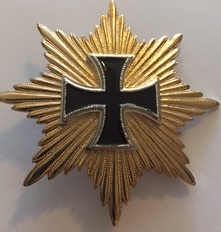
In 1815 the Star of the Grand Cross of the Iron Cross was created. It recognized senior military leaders whose performance greatly benefited Prussia. The first was awarded to Field Marshal Gebhard von Blucher, for his victory over Napoleon at Waterloo. Only one other was ever awarded. This went to Field Marshal Paul von Hindenberg for his victory over the Russians at the Battle of Tannenberg in World War One. American soldiers found a third medal in the closing days of World War Two. This medal now resides in the museum at West Point. A Grand Cross was also created for senior officers. It was a little larger than the regular Iron Cross and was suspended by a ribbon around the neck.
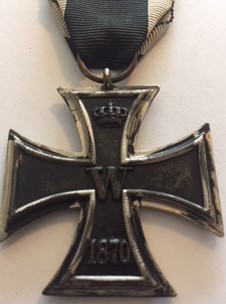
In 1870, a new Iron Cross was created by King William I of Prussia and first awarded during the Franco-Prussian War of 1870-71. This version showed the royal crown, the initial “W” for William, and the date 1870, inscribed on the front. The reverse of the Second Class version showed the royal crown, the initials “FW” for Frederick Wilhelm and the date 1813. Oak leaves decorated the center of the reverse. A non-combatant version was also created. The non-combatant version was identical to the combat version but was suspended from a white ribbon with two black stripes, the reverse of the combatant medal. With the creation of the German empire in 1872, the Iron Cross became a German military award. The next version to appear was for World War One (1914-1918). This version was similar to the 1870 version except the “W” now stood for Kaiser Wilhelm II and the date was changed to 1914. The reverse remained the same as previous versions, with the “FW”, crown, oak leaves, and 1813 date. In 1918, the Iron Cross went dormant following the abdication of the Kaiser and the end of the Second Reich.
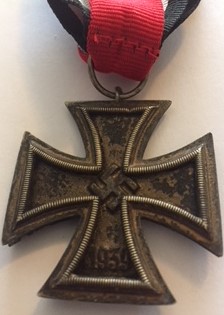
Adolf Hitler revised the medal in 1939. The new version did not have the crown. The initials were replaced with the swastika. The front was dated 1939. The reverse continued to show the date 1813, but the oak leaves and crown were removed. To show his distain for the Hohenzollern family, Hitler added a large red strip down the center of the black and white ribbon. Hitler also replaced the Grand Cross with the Knight’s Cross. The Knight’s Cross became the highest decoration of the Third Reich, when Hitler refused to reinstate the Pour le Me ‘rite (Blue Max), which he considered an elitist award of the old regime. The Knight’s Cross was also suspended from a ribbon around the neck. It could be awarded in degrees, with oak leaves, crossed swords, and diamonds. When the Iron Cross, Second Class was awarded, the ribbon was worn in a buttonhole of the tunic. The Second Class medal itself was only worn on the dress uniform.
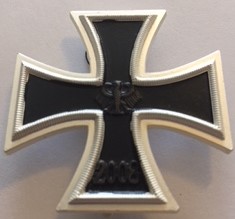
In 1945, the Iron Cross was abolished. In 1957, German veterans petitioned the government for permission to wear their decorations at memorial and veteran affairs. The problem was the swastika was prohibited in Germany. The government resolved the issue by creating a 1957 version of the 1939 Iron Cross. The 1957 version replaced the swastika with oak leaves. The 1939 date remained. Awardees could turn their 1939 Third Reich medals in to the government and receive a 1957 variant they could wear in public. With Germany’s participation in Afghanistan, the German government was petitioned in 2006 to reinstate the Iron Cross as a valor award. In 2008, a prototype was submitted for consideration. The prototype showed the German Eagle and the date 2008. The German government decided the prototype looked too much like the original Third Reich version and denied the request. Instead, the government reclassified the Medal of Merit of the German armed forces as the new valor award. This ended the sometimes illustrious, often notorious history of the Iron Cross. The Iron Cross remains one of the iconic valor decorations in military history.
Would you like to learn more about German history? Join us on Military Historical Tour’s “Rise and Fall of the Third Reich” tour. See brochure at https://www.miltours.com/index.php?route=product/product&path=17&product_id=81
